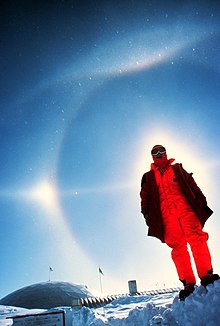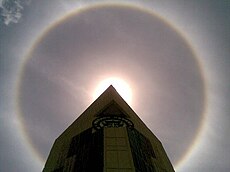Halo (fenomena optis): Perbedaan antara revisi
TENTANG HALO |
WillsonEP09 (bicara | kontrib) Tag: Pengembalian Suntingan perangkat seluler Suntingan peramban seluler Suntingan seluler lanjutan |
||
| (15 revisi perantara oleh 7 pengguna tidak ditampilkan) | |||
| Baris 1: | Baris 1: | ||
[[Berkas:Sun_halo_optical_phenomenon_edit.jpg|jmpl|Halo di [[Kutub Selatan]].]] |
[[Berkas:Sun_halo_optical_phenomenon_edit.jpg|jmpl|Halo di [[Kutub Selatan]].]] |
||
[[Berkas:Halo_padang.jpg|jmpl|230px|Photo Halo di atas gedung pusat Semen |
[[Berkas:Halo_padang.jpg|jmpl|230px|Photo Halo di atas gedung pusat Semen Padang, Indonesia, 2 Oktober, 2009 11:09.]] |
||
'''Halo''' ({{unicode|ἅλως}} |
'''Halo''' (dari [[bahasa Yunani]] {{unicode|ἅλως}}<ref>{{Cite web|last=|first=|date=|title=Henry George Liddell, Robert Scott, A Greek-English Lexicon, ἅλως|url=http://www.perseus.tufts.edu/hopper/text?doc=Perseus:text:1999.04.0057:entry=a(/lws|website=www.perseus.tufts.edu|access-date=6 Oktober 2020|archive-date=2023-03-22|archive-url=https://web.archive.org/web/20230322010215/https://www.perseus.tufts.edu/hopper/text?doc=Perseus%3Atext%3A1999.04.0057%3Aentry%3Da(%2Flws|dead-url=no}}</ref>{{Sfn|Johnson|(2009)|p=325a|ps=, "The Greeks called such things the ‘halo’ (ή άλως), perhaps because of their resemblance to a circular threshing floor (άλως).}}) adalah [[fenomena optis]] berupa lingkaran [[cahaya]] di sekitar [[matahari]] dan [[bulan]], dan kadang-kadang pada sumber cahaya lain seperti lampu penerangan jalan. Ada berbagai macam halo, tetapi umumnya halo muncul disebabkan oleh [[kristal es]] pada [[awan cirrus]] (biasanya cirrostratus) yang dingin yang berada 5–10 km atau 3–6 mil di lapisan atas [[troposfer]]. Fenomena ini bergantung pada bentuk dan arah [[kristal]] [[es]], cahaya matahari direfleksikan dan dibiaskan oleh permukaan es yang berbentuk [[batang]] atau [[prisma]] sehingga sinar matahari menjadi terpecah kedalam beberapa warna karena efek [[dispersi]] udara dan dipantulkan ke arah tertentu, sama seperti pada [[pelangi]]. |
||
Halo juga kadang-kadang dapat muncul di dekat permukaan bumi, ketika ada kristal es yang disebut [[debu berlian]]. Kejadian ini dapat terjadi pada cuaca yang sangat dingin, ketika kristal es terbentuk di dekat permukaan dan memantulkan cahaya. |
Halo juga kadang-kadang dapat muncul di dekat permukaan bumi, ketika ada kristal es yang disebut [[debu berlian]]. Kejadian ini dapat terjadi pada cuaca yang sangat dingin, ketika kristal es terbentuk di dekat permukaan dan memantulkan cahaya. |
||
Sebelum ilmu [[meteorologi]] dikembangkan, Fenomena atmosfer Halo digunakan sebagai sarana untuk prakiraan cuaca. |
Sebelum ilmu [[meteorologi]] dikembangkan, Fenomena atmosfer Halo digunakan sebagai sarana untuk prakiraan cuaca.<ref>{{Cite web|last=|first=|date=2002-02-25|title=Weather Forecasting Through the Ages|url=https://earthobservatory.nasa.gov/features/WxForecasting/wx2.php|website=earthobservatory.nasa.gov|language=en|access-date=6 Oktober 2020|archive-date=2009-01-22|archive-url=https://web.archive.org/web/20090122122952/https://earthobservatory.nasa.gov/features/WxForecasting/wx2.php|dead-url=no}}</ref> |
||
== Sejarah == |
|||
AKWKWOAOWOAKOWAKWOAKOWAKOWAKWOAKO |
|||
[[Berkas:Gianlorenzo bernini, costantino, 1670, 02.jpg|jmpl|Patung ''Penglihatan Konstantin'']] |
|||
Penampakan halo telah tercatat sejak zaman dahulu. [[Penduduk Asli Amerika|Penduduk asli Amerika]] menggambarkan halo dalam [[petroglif]]. Di [[Tiongkok kuno]], seorang kaisar menulis sebuah buku bergambar tentang halo. Sekarang, diyakini bahwa yang disebut sebagai 'penglihatan [[Paganisme|pagan]]' yang diyakini [[Konstantinus Agung|Konstantin]] sebagai tanda dari dewa<ref>{{Cite journal|last=Saylor Rodgers|first=Barbara|date=1980|title=CONSTANTINE'S PAGAN VISION|url=https://www.jstor.org/stable/44170618|journal=Byzantion|volume=50|issue=1|pages=;261|doi=|issn=0378-2506|quote=When Constantine approached the temple to thank the gods for his good fortune, he saw that the gods were awaiting his arrival (...) The panegyric contains a specific message, symbolized and summarized in the account of the vision, which the orator, presumably with the emperor's approval, wanted to his audience.}}</ref> disebabkan oleh halo matahari spektakuler yang dia saksikan pada tahun 330 M.<ref>{{Cite journal|last=Zinkova|first=Mila|date=2018|title=Ice halos in weather lore and meteorology, and a rare halo display in San Francisco|url=https://rmets.onlinelibrary.wiley.com/doi/abs/10.1002/wea.3237|journal=Weather|language=en|volume=73|issue=8|pages=239|doi=10.1002/wea.3237|issn=1477-8696|quote=Native Americans depicted halos in petroglyphs (Sassen, 1994). Ice halos were known to the ancient Chinese, where the emperor himself wrote an illustrated book about halos (Ping-Yü and Needham, 1959). It is now widely believed that the so-called ‘pagan vision’ of Constantine was caused by a spectacular solar halo he observed in AD 330 (Weiss, 2003).|access-date=2020-10-06|archive-date=2023-08-13|archive-url=https://web.archive.org/web/20230813122313/https://rmets.onlinelibrary.wiley.com/doi/abs/10.1002/wea.3237|dead-url=no}}</ref> |
|||
[[Aristoteles]] telah meneliti halo dan fenomena langit lain di zamannya.{{Sfn|Johnson|(2009)|p=325b|ps=, "Aristotle tried to explain why halos always appear to form a complete circle, unlike related meteorological phenomena such as rainbows, parhelia, and ‘rods’."}} Penggambaran halo yang rumit pertama kali di Eropa ditulis oleh [[Christoph Scheiner]] di [[Roma]] (sekitar 1630), [[Johannes Hevelius|Hevelius]] di [[Gdańsk|Danzig]] (1661), dan Tobias Lowitz di [[Sankt-Peterburg|St Petersburg]] (sekitar 1794). Pengamat Tiongkok telah mencatat penampakan halo selama berabad-abad. Dalam catatan "Sejarah Resmi Dinasti Chin" (''Chin Shu'') tahun 637 bab Astronomi, terdapat bagian berjudul 'Sepuluh Halo' (''shih yün''). Dalam bab tersebut, tercatat 26 istilah-sitilah yang berkaitan dengan penampakan halo di [[Tata Surya]].<ref>{{Cite journal|last=Ping‐Yü|first=Ho|last2=Needham|first2=Joseph|date=1959|title=Ancient Chinese Observations of Solar Haloes and Parhelia|url=https://rmets.onlinelibrary.wiley.com/doi/abs/10.1002/j.1477-8696.1959.tb02450.x|journal=Weather|language=en|volume=14|issue=4|pages=124–134|doi=10.1002/j.1477-8696.1959.tb02450.x|issn=1477-8696|quote=THE first European description of a complex display of haloes and mock suns was that of Christopher Scheiner in +1630, who saw one at the rather southerly latitude of Rome ; the next was that of Hevelius at Danzig in + 1661, but the most elaborate and complicated effect ever seen was probably that described by Tobias Lowitz at St. Petersburg in +1794. (...) The section on the ' Ten Haloes ' (''shih yün'') in one of the astronomical chapters of the ''Chin Shu'' (Official History of the Chin Dynasty), completed about +635, contains some twenty-six technical terms which can be identified with almost every component of the solar halo system.|access-date=2020-10-06|archive-date=2020-10-08|archive-url=https://web.archive.org/web/20201008205908/https://rmets.onlinelibrary.wiley.com/doi/abs/10.1002/j.1477-8696.1959.tb02450.x|dead-url=no}}</ref> |
|||
== Rujukan == |
|||
<references /> |
|||
== Daftar Pustaka == |
|||
* {{Cite journal|last=Johnson|first=Monte Ransome|date=2009-01-01|title=The Aristotelian Explanation of the Halo|url=http://dx.doi.org/10.1515/apeiron.2009.42.4.325|journal=Apeiron|volume=42|issue=4|pages=|doi=10.1515/apeiron.2009.42.4.325|issn=2156-7093|ref={{Sfnref|Johnson|(2009)}}|access-date=2020-10-06|archive-date=2023-08-13|archive-url=https://web.archive.org/web/20230813122311/https://www.degruyter.com/document/doi/10.1515/APEIRON.2009.42.4.325/html|dead-url=no}} |
|||
== Pranala luar == |
== Pranala luar == |
||
{{commons|Halo}} |
{{commons|Halo}} |
||
* [http://www.atoptics.co.uk/halosim.htm Halo explanations and image galleries] at [http://www.atoptics.co.uk/ Atmospheric Optics] |
* [http://www.atoptics.co.uk/halosim.htm Halo explanations and image galleries] {{Webarchive|url=https://web.archive.org/web/20130728133158/http://www.atoptics.co.uk/halosim.htm |date=2013-07-28 }} at [http://www.atoptics.co.uk/ Atmospheric Optics] {{Webarchive|url=https://web.archive.org/web/20120117121519/http://www.atoptics.co.uk/ |date=2012-01-17 }} |
||
* [http://www.meteoros.de/haloe.htm Meteoros AKM - Halo explanations and image galleries] |
* [http://www.meteoros.de/haloe.htm Meteoros AKM - Halo explanations and image galleries] {{Webarchive|url=https://web.archive.org/web/20131217133848/http://www.meteoros.de/haloe.htm |date=2013-12-17 }} |
||
* [http://haloreports.blogspot.com Halo reports of interesting halo observations around the World] |
* [http://haloreports.blogspot.com Halo reports of interesting halo observations around the World] {{Webarchive|url=https://web.archive.org/web/20200925175741/http://haloreports.blogspot.com/ |date=2020-09-25 }} |
||
* [http://www.astronomy.net.nz Southern Hemisphere Halo and other atmospheric phenomena] |
* [http://www.astronomy.net.nz Southern Hemisphere Halo and other atmospheric phenomena] {{Webarchive|url=https://web.archive.org/web/20190119030529/http://astronomy.net.nz/ |date=2019-01-19 }} |
||
* [http://www.lumis.com/tag/Moon_Ring/page1/ Moon Halo Gallery] |
* [http://www.lumis.com/tag/Moon_Ring/page1/ Moon Halo Gallery] {{Webarchive|url=https://web.archive.org/web/20080220105203/http://www.lumis.com/tag/Moon_Ring/page1/ |date=2008-02-20 }} |
||
* [http://valeriu.tihai.md/?p=280 Halo in Chisinau Moldova (photo and video] |
* [http://valeriu.tihai.md/?p=280 Halo in Chisinau Moldova (photo and video] {{Webarchive|url=https://web.archive.org/web/20070928041748/http://valeriu.tihai.md/?p=280 |date=2007-09-28 }} |
||
* [http://www.detiknews.com/read/2009/10/02/121219/1213668/10/fenomena-halo-muncul-di-kota-padang Sun Halo appeared in Padang after the earthquake] |
* [http://www.detiknews.com/read/2009/10/02/121219/1213668/10/fenomena-halo-muncul-di-kota-padang Sun Halo appeared in Padang after the earthquake] {{Webarchive|url=https://web.archive.org/web/20091005150528/http://www.detiknews.com/read/2009/10/02/121219/1213668/10/fenomena-halo-muncul-di-kota-padang |date=2009-10-05 }} |
||
{{Authority control}} |
|||
{{fisika-stub}} |
|||
[[Kategori:Astronomi obervasi]] |
[[Kategori:Astronomi obervasi]] |
||
Revisi terkini sejak 29 Juli 2024 10.26


Halo (dari bahasa Yunani ἅλως[1][2]) adalah fenomena optis berupa lingkaran cahaya di sekitar matahari dan bulan, dan kadang-kadang pada sumber cahaya lain seperti lampu penerangan jalan. Ada berbagai macam halo, tetapi umumnya halo muncul disebabkan oleh kristal es pada awan cirrus (biasanya cirrostratus) yang dingin yang berada 5–10 km atau 3–6 mil di lapisan atas troposfer. Fenomena ini bergantung pada bentuk dan arah kristal es, cahaya matahari direfleksikan dan dibiaskan oleh permukaan es yang berbentuk batang atau prisma sehingga sinar matahari menjadi terpecah kedalam beberapa warna karena efek dispersi udara dan dipantulkan ke arah tertentu, sama seperti pada pelangi.
Halo juga kadang-kadang dapat muncul di dekat permukaan bumi, ketika ada kristal es yang disebut debu berlian. Kejadian ini dapat terjadi pada cuaca yang sangat dingin, ketika kristal es terbentuk di dekat permukaan dan memantulkan cahaya.
Sebelum ilmu meteorologi dikembangkan, Fenomena atmosfer Halo digunakan sebagai sarana untuk prakiraan cuaca.[3]
Sejarah
[sunting | sunting sumber]
Penampakan halo telah tercatat sejak zaman dahulu. Penduduk asli Amerika menggambarkan halo dalam petroglif. Di Tiongkok kuno, seorang kaisar menulis sebuah buku bergambar tentang halo. Sekarang, diyakini bahwa yang disebut sebagai 'penglihatan pagan' yang diyakini Konstantin sebagai tanda dari dewa[4] disebabkan oleh halo matahari spektakuler yang dia saksikan pada tahun 330 M.[5]
Aristoteles telah meneliti halo dan fenomena langit lain di zamannya.[6] Penggambaran halo yang rumit pertama kali di Eropa ditulis oleh Christoph Scheiner di Roma (sekitar 1630), Hevelius di Danzig (1661), dan Tobias Lowitz di St Petersburg (sekitar 1794). Pengamat Tiongkok telah mencatat penampakan halo selama berabad-abad. Dalam catatan "Sejarah Resmi Dinasti Chin" (Chin Shu) tahun 637 bab Astronomi, terdapat bagian berjudul 'Sepuluh Halo' (shih yün). Dalam bab tersebut, tercatat 26 istilah-sitilah yang berkaitan dengan penampakan halo di Tata Surya.[7]
Rujukan
[sunting | sunting sumber]- ^ "Henry George Liddell, Robert Scott, A Greek-English Lexicon, ἅλως". www.perseus.tufts.edu. Diarsipkan dari versi asli tanggal 2023-03-22. Diakses tanggal 6 Oktober 2020.
- ^ Johnson (2009), hlm. 325a, "The Greeks called such things the ‘halo’ (ή άλως), perhaps because of their resemblance to a circular threshing floor (άλως).
- ^ "Weather Forecasting Through the Ages". earthobservatory.nasa.gov (dalam bahasa Inggris). 2002-02-25. Diarsipkan dari versi asli tanggal 2009-01-22. Diakses tanggal 6 Oktober 2020.
- ^ Saylor Rodgers, Barbara (1980). "CONSTANTINE'S PAGAN VISION". Byzantion. 50 (1): ;261. ISSN 0378-2506.
When Constantine approached the temple to thank the gods for his good fortune, he saw that the gods were awaiting his arrival (...) The panegyric contains a specific message, symbolized and summarized in the account of the vision, which the orator, presumably with the emperor's approval, wanted to his audience.
- ^ Zinkova, Mila (2018). "Ice halos in weather lore and meteorology, and a rare halo display in San Francisco". Weather (dalam bahasa Inggris). 73 (8): 239. doi:10.1002/wea.3237. ISSN 1477-8696. Diarsipkan dari versi asli tanggal 2023-08-13. Diakses tanggal 2020-10-06.
Native Americans depicted halos in petroglyphs (Sassen, 1994). Ice halos were known to the ancient Chinese, where the emperor himself wrote an illustrated book about halos (Ping-Yü and Needham, 1959). It is now widely believed that the so-called ‘pagan vision’ of Constantine was caused by a spectacular solar halo he observed in AD 330 (Weiss, 2003).
- ^ Johnson (2009), hlm. 325b, "Aristotle tried to explain why halos always appear to form a complete circle, unlike related meteorological phenomena such as rainbows, parhelia, and ‘rods’."
- ^ Ping‐Yü, Ho; Needham, Joseph (1959). "Ancient Chinese Observations of Solar Haloes and Parhelia". Weather (dalam bahasa Inggris). 14 (4): 124–134. doi:10.1002/j.1477-8696.1959.tb02450.x. ISSN 1477-8696. Diarsipkan dari versi asli tanggal 2020-10-08. Diakses tanggal 2020-10-06.
THE first European description of a complex display of haloes and mock suns was that of Christopher Scheiner in +1630, who saw one at the rather southerly latitude of Rome ; the next was that of Hevelius at Danzig in + 1661, but the most elaborate and complicated effect ever seen was probably that described by Tobias Lowitz at St. Petersburg in +1794. (...) The section on the ' Ten Haloes ' (shih yün) in one of the astronomical chapters of the Chin Shu (Official History of the Chin Dynasty), completed about +635, contains some twenty-six technical terms which can be identified with almost every component of the solar halo system.
Daftar Pustaka
[sunting | sunting sumber]- Johnson, Monte Ransome (2009-01-01). "The Aristotelian Explanation of the Halo". Apeiron. 42 (4). doi:10.1515/apeiron.2009.42.4.325. ISSN 2156-7093. Diarsipkan dari versi asli tanggal 2023-08-13. Diakses tanggal 2020-10-06.
Pranala luar
[sunting | sunting sumber]- Halo explanations and image galleries Diarsipkan 2013-07-28 di Wayback Machine. at Atmospheric Optics Diarsipkan 2012-01-17 di Wayback Machine.
- Meteoros AKM - Halo explanations and image galleries Diarsipkan 2013-12-17 di Wayback Machine.
- Halo reports of interesting halo observations around the World Diarsipkan 2020-09-25 di Wayback Machine.
- Southern Hemisphere Halo and other atmospheric phenomena Diarsipkan 2019-01-19 di Wayback Machine.
- Moon Halo Gallery Diarsipkan 2008-02-20 di Wayback Machine.
- Halo in Chisinau Moldova (photo and video Diarsipkan 2007-09-28 di Wayback Machine.
- Sun Halo appeared in Padang after the earthquake Diarsipkan 2009-10-05 di Wayback Machine.
